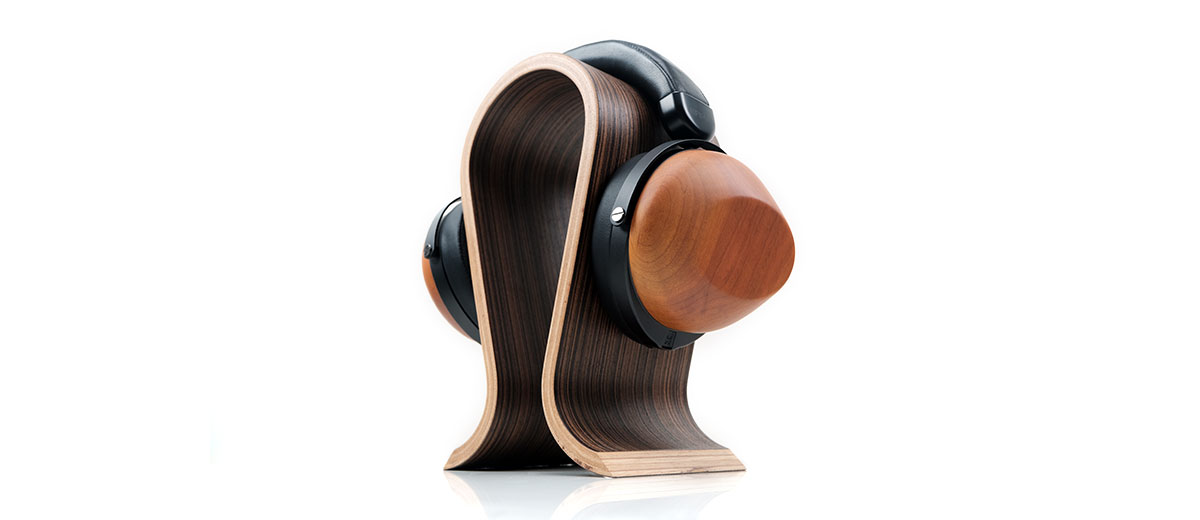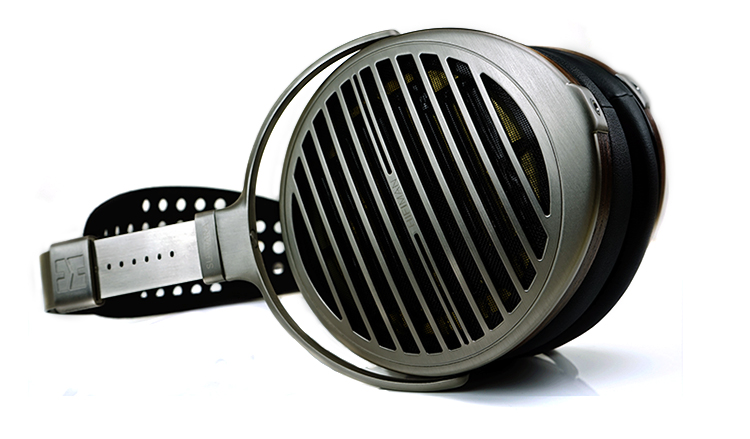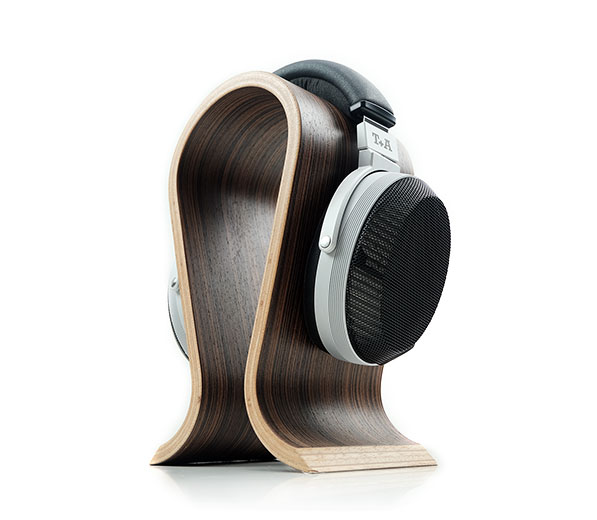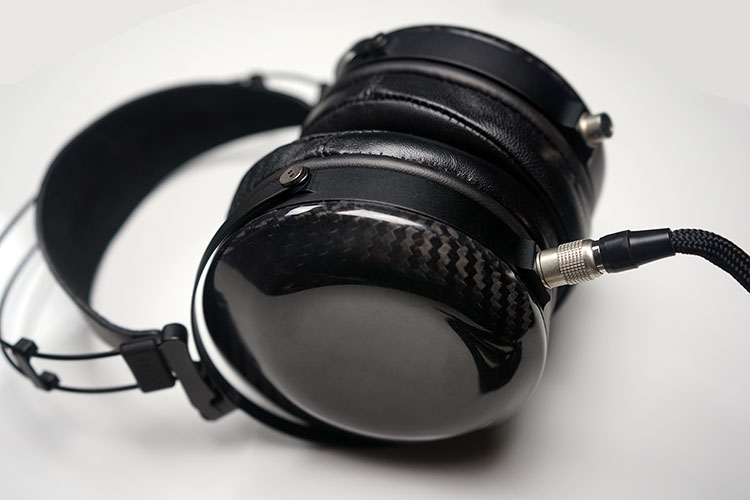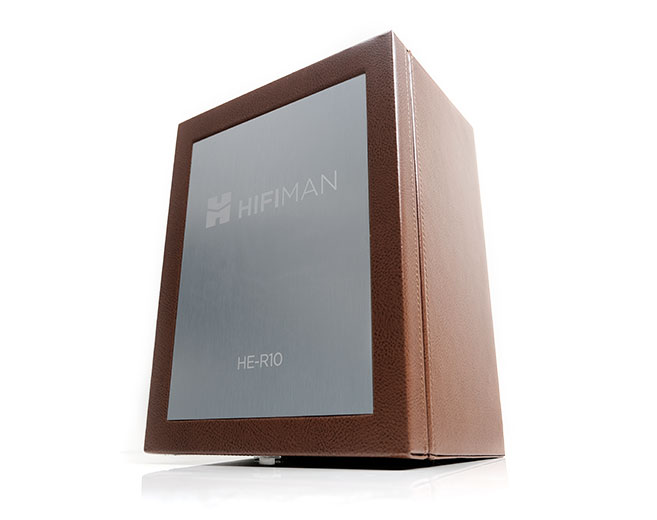Select Comparisons
HIFIMAN Susvara
$6000
Technical
The Susvara is Hifiman’s current flagship headphone and quite a different approach to the HE-R10P though with a couple of shared characteristics. Both are circumaural headphones and both use Hifiman’s NSD nanotech diaphragm with a dual-sided stealth magnet design. That is where the commonalities pretty much end.
The Susvara is an open-back window-shade acoustical design, a characteristic born from the HE1000 series whereas the HE-R10P is a closed-back wood cup implementation.
Though details are scant, the drivers are entirely different despite sharing the NSD technology. I would suspect this is on the trace design and materials used with the HE-R10P not using a gold-coated conductive diaphragm.
The other key technical difference is their efficiency with the Susvara being far harder to drive than the HE-R10P at 63Ω and 83dB SPL compared to 30Ω and 100dB.
The Susvara will be eternally chained to a quality desktop to reach optimal efficiency, however, not only will the HE-R10P be a possible quality DAP pairing but also opens it up to being driven adequately by the Bluemini wireless module. Both have their pros and cons in terms of sound quality which you can read below.
Design
The Susvara is actually just 10g lighter than the HE-R10P but it looks a lot smaller and feels lighter even though it isn’t. Bear in mind the Bluemini will add that additional 25g in weight to the HE-R10P but it is barely noticeable.
The materials are also quite different from the veneer wood and predominant metal design of the Susvara compared to the striking R10-inspired cherry wood cups and mic of metal and plastics on the HE-R10P. Real wood is always preferred but I do have a preference for the Susvara finishing in general which has more of a premium feel.
The comfort levels of the Susvara are slightly better but the HE-R10P does quite well and is nothing like the weight of the HEDDPhone or the Rosson Audio Design RAD-0. Neither Hifiman headphones are weighty on your head or clamp that hard, however, the Susvara headband distributes the vertical weight a bit better and seems steadier.
Also, the Susvara has a dual-entry design so not compatible with the Bluemini, not that it matters much given its efficiency rating. The supplied cables with the HE-R10P are the same in terms of wiring and jack terminations though this edition here is a 2.5m mono plug termination whereas the HE-R10P has a stronger 3.5mm TRS connector.
The HE-R10P cables have the better jacket finish but I believe these cables are now standard on the Susvara also since I reviewed it back in 2017.
Performance
In a way, the HE-R10P is exactly how I imagined a closed-back Susvara would sound. It has a wonderful ability to sound big with excellent staging capability just not quite as open and airy as the Susvara.
The HE-R10P delivers on clarity and speed just not quite as resolving or as delicate as the Susvara, particularly in the treble response and amount of separation. It is close though and they belong in the same family as me in terms of the type of performance you would expect from a top-tier planar headphone.
The key differences for me outside of the differing staging capability are the bass tuning and the midrange positioning. Both of these aspects produce a change to the timbre of the HE-R10P which for me is the denser and more physical sounding of the two headphones.
Low-End
The Susvara low-end is very linear and evenly tuned from 20Hz right up to almost 1k. If anything, it’s a very gentle rise up through the mid-bass and lower mids but the transition is absolutely seamless meaning transients are very fast and very precise throughout.
The HE-R10P has a bit more weight on the sub-bass from 30Hz to 60Hz and a minor drop to the upper bass before rising fairly quickly into the mids.
This is more of a classic closed-back tuning for me sounding the weightier and fuller of the two in terms of rumble and impact. If you want amazing precision and clarity on the low-end pick the Susvara, for a bit more slam pick the HE-R10P.
Mids
Mids are also quite different. The HE-R10P sounds fuller and closer, with more warmth and presence shining through from the low-end into the lower-mids as well as a stronger vocal presence positioned to the fore.
That is pretty steady up to 3k whereas the Susvara stays relatively neutral or slightly further back with better separation and width from 1-3k
That tuning does contribute to a more grandiose perception of the Susvara staging whereas the midrange peak pulls the HE-R10P into a slightly more intimate staging quality in the midrange with that stronger vocal focus.
Treble
The HE-R10P treble will sound relatively softer and slightly darker in comparison to the Susvara’s airy almost ethereal-like quality though in its own right, I would not call this a dark-sounding headphone.
Rather the Susvara has a bit more bite and presence around 4-5k and only a minor dip from 5-7k and stays very articulate up to 10k and beyond whereas the HE-R10P has a more muted upper mids and lower treble and more of a peak around 8-9k that gives the instrumental timbre a nice balance between sweet and rounded.
T+A Solitaire P
$6400
Technical
We did review the flagship T+A Solitaire P last year and it walked away with one of our Top Gear Awards for 2020 as well. Now, I did not review it personally, Smit did but I do happen to have one that arrived recently and we will be including it in subsequent reviews including this one.
The Solitaire P is a circumaural open-back planar magnetic headphone as opposed to the HE-R10P’s closed-back circumaural design and both have a hefty price tag. Like the HE-R10P, the Solitaire P has a focus on diaphragm construction but with a very different application.
The Solitaire P uses a process called vapor deposition as opposed to a regular trace design to effectively render both coil and diaphragm as one coherent surface. This is combined with 19 neodymium magnets to ensure the full area of this diaphragm is being used in the linear part of the magnetic field.
The HE-R10P is quite different by going for an ultra-thin nano-level thickness in the diaphragm and an asymmetrical magnet design, (stealth magnets), to maximize both the speed, clarity, and dynamic range of its driver.
In terms of efficiency, there is a bit of a difference with the Solitaire P rated at a much higher impedance of 80Ω and a fairly efficient 100dB SPL. The impedance of the HE-R10P is much lower at 32Ω but with a similar SPL of 100dB.
In our real-world testing, the Solitaire P was less efficient compared to the H-R10P needing a bit more current with our paired amps including the Bartok and the V590.
Design
Quite apart from one being open and the other being closed, the design approach of these two headphones is incredibly different. The Solitaire P has a smaller form factor compared to the HE-R10P but is slightly heavier at 490g compared to 460g.
The aesthetics are also quite a contrast with the Solitaire P handmade in Germany and offers a very Sennheiser-like urban design with a mix of silvery CNC-milled aluminum cups and gimbals. The plates are a matte black steel grill that allows you to peer very clearly into the driver’s design.
This is a striking almost retro dual-entry design topped off with copious amounts of alcantara for the elongated earpads and underside of the synthetic leather headband.
By comparison, the HE-R10P is a bit more electric with its beautiful cherry wood grain cups mixed in with cheaper plastic pivot blocks, larger round hybrid protein leather, polyester pads, and a deep memory foam headband wrapped in leather.
The HE-R10P looks a lot more striking and unique but it does feel a little cheaper in terms of the quality of materials compared to the Solitaire P.
For comfort, both have a similar weight and clamping pressure so there is a slight vertical downward bias with the majority of the pull from the cups and magnets inside them. I must say though the Alcantara pads on the Solitaire P are incredibly soft and comfortable.
The Solitaire P comes with a 3m SE 6.35mm and a 3m 4.4mm balanced terminated cable with both using Lemo-style push-pull connectors. Both are finished in a heavy rubbery jacket and look the business.
However, I do prefer the much lighter nylon jacket finish of the single-entry Hifiman cables with the simpler 3.5mm TRS connectors. They are a lot easier to work with.
Performance
The Solitaire P could be classified as more of a planar ‘reference’ compared to the more ‘fun’ FR bias of the HE-R10P. Fun might be a throwaway term in this regard, but certainly, the HE-R10P has more peaks and dips up to the mids compared to the linear planar bass response of the Solitaire P.
The one difference is 20-50Hz where the HE-R10P has more elevation and rumble than the Solitaire P but then it dips a bit more into the mid and upper bass before rising through the mids creating a leaner mid-bass tone.
The Solitaire P stays true and straight up to the lower mids or around 500Hz with only the subtlest of drops to 1k – a very even response. The HE-R10P is much more mid-forward compared to the Solitaire P with a lift starting around 500Hz and staying fairly elevated to around 3k.
The Solitaire P ascends a bit later around 2k with a minor drop at 4k, peaking closer to 6-8k where you hear more energy. The HE-R10P dips around 4k more aggressively with its treble energy further up around 8-10k.
That affects both imaging and timbre between these two with the HE-R10P offering a sweeter softer tone with a little bit of odd-harmonic sparkle and the Solitaire P a more accurate but slightly cooler timbral balance. Vocals positioning is also a bit more neutral in terms of imaging and not quite as strong in their dominance as the HE-R10P.
If anything, the Solitaire P upper mids do lack a little bit of even-harmonic warmth in them and the tendency is to hear a brighter mid-treble influence in comparison. Mind you, the Solitaire does have a bit more headroom and air in the treble department compared to the HE-R10P which does not surprise me.
Dan Clark Audio Ether C Flow
$1799
Technical
Despite being launched a few years ago, the Ether C Flow is still Dan Clark Audio’s flagship closed-back planar headphone. The original Ether C was a non-flow edition in early 2016 with the Flow Edition coming out later that year. There was also a subsequent filter tweaked version in late 2018 which we reviewed here.
The planar implementation on the Ether C Flow has a big focus on air management as opposed to the diaphragm thickness. Mind you, the double-sided stealth magnet design on the HE-R10P does work to manage soundwave and air movement more efficiently and cleanly so there is a common concern here.
The Ether C Flow though is different with their use of their proprietary TrueFlow system, hence the name Flow. Their waveguide technology smooths the path for air moving into, through, and out of the magnet structure to reduce distortion and improve dynamics.
The DCA Ether C Flow also still uses their V-Planar technology which is a knurling variation on planar driver manufacturing to produce a concertina action on the diaphragm to improve stability and reduce nasty artifacts.
The equivalent of the RE-10P is the NSD nanotechnology implementation to make the diaphragm tight, light, and as thin as possible. This driver is built for speed and a fast-sounding dynamic response.
The efficiency of them both does contrast with the Ether C Flow at 23Ω and 96dB SPL and is a little less efficient compared to the HE-R10P’s 30Ω and 100dB rating.
I tend to find the C Flow to be more demanding to drive than the specs might suggest and certainly, it is more comfortable with a desktop amplifier than a DAP whereas the HE-R10P is more flexible as well as offering wireless capability.
Design
Whilst both are closed-back headphones they have radically different designs. The form factor of the Ether C Flow is smaller and with the use of that excellent NiTinol memory metal headband, it is also quite a bit lighter at 370g compared to 460g.
The Ether C Flow cups are carbon fiber finished, 3D printed, and a lot shallower compared to the striking cherry wood cups of the HE-R10p. The pads are also made of a higher quality lambskin leather and feel incredibly plush compared to the slightly stiffer but lighter pads on the HE-R10P.
I do have to give the edge to the Ether C Flow in terms of comfort, pressure balance, and isolation. The lighter Ether C Flow strap system mitigates any vertical pressure and the clamping is just a shade firmer which helps keep it in place. The HE-R10P is also quite relaxed in its fitting but is competitively less secure on my head.
The softer pads seal a bit better but then again the more porous nature of the HE-R10P pads may have some effect on the more open sound quality compared to the closed-in feel of the Ether C Flow presentation.
The Ether C Flow is a dual-entry Hirose connector system that I find quite secure but it does add some weight to the supplied VIVO cable. You only get one cable as opposed to 3 with the Ether C Flow but you can have it terminated with a wide variety of connectors including 4.4mm which the HE-R10P does not offer.
The HE-R10P’s single entry system does mean a lighter cable as well as being able to offer the Bluemini wireless option which essentially makes it two different headphones for the price of one.
Performance
(Note this comparison was done with the Ether C Flow V1.1 DIY mode kit which reduces the mid-bass bump and 400Hz dip to offer a smoother bass-to-mids transition and generally a more open sound.)
The Ether C Flow is a great closed-back planar headphone but in comparison, the HE-R10P is a huge step up in terms of dynamic range, staging vastness, and timbral detail.
Honestly, the C Flow V1.1 sounds smaller and flatter in terms of imaging with less of a black background. The presentation is denser, more center-focused, and not as tall or as deep with less stereo width and instrumental separation.
Low-End
Both have a slightly elevated low-end as I would expect from closed-backs but with the Ether C Flow V1.1, it is a bit more linear with warmth in the mid-bass and upper mids whereas the HE-R10P is deeper, with more of a sub-bass lift and less mid-bass warmth.
The Ether C Flow v1.1 stays fairly linear to 1k then has a slow dip to 4k whereas the HE-R10P stays elevated with a sharper narrower 3-5k dip and rise.
Timbre
The timbre of the Ether C Flow has a bit more density on the mid-bass and lower-mids but is drier and slightly harsher up top.
The HE-R10p timbre is a little lighter on the lower-mids but sweeter sounding throughout with a more refined treble tone. On the original Ether C Flow without the mod kit, the bass was boomier for me with less clarity and presence in the mids.
Vocals
Both vocal performances actually are to the fore but with the Ether C Flow, it is more that everything feels a bit closer and denser whereas the HE-R10P vocals are primarily to the fore, and the rest of the stage is spread around in a more holographic fashion. The Flow is front and center for the mids whereas the HE-R10P is enveloping and immersive.
That’s where the superior width and headroom of the HE-R10P come into play allowing you to pick up on the delicate spatial cues and better instrumental layering that bit easier than with the Ether C Flow.
Our Verdict
The HE-R10P is easily one of the best closed-back planar headphones I have heard to date and can give plenty of open-backs a bit of a run for their money also.
Granted, that may be somewhat of a pyrrhic victory given the paucity of closed-back choices on the market today but it does go some way to justifying both the driver and the acoustical chamber design to get such a remarkably open and sweet sound. Certainly, the HE-R10P sits close to the Susvara in terms of technical performance alone.
The aesthetics are more of a mixed bag. It is a big headphone but much comfier than I imagined it to be and easier on the head than some of the competing flagship headphones such as the LCD-4. The cherry wood is quite an appealing material for the cups, however, the various grades of materials used and ‘memorable’ design will stir up some distracting debate.
If you can grab the Bluemini, do so. I am really surprised by how easy the HE-R10P is to drive. It opens up a lot of doors for portable source users and yes, the Bluemini does a pretty decent job in converting the HE-R10P into a Bluetooth headphone that far surpasses any other BT headphone I have heard to date, including the Ananda BT.
HIFIMAN HE-R10P Specifications
- Frequency Response: 10Hz-60kHz
- Impendence: 30Ω
- Sensitivity: 100dB
- Weight: 460g
- Socket: 3.5mm Balanced
Bluemini Specifications
- Frequency Response: 20 Hz-20kHz
- AMP Output: 230mw
- TDH: <0.1% @ 1W/1KHz
- SNR: 95dB
- Battery Life: 7-10 Hours
- Weight: 25g
- Bluetooth Codecs: LDAC, aptx-HD, aptX, AAC, SBC
- Transmission: Bluetooth/USB Type C

